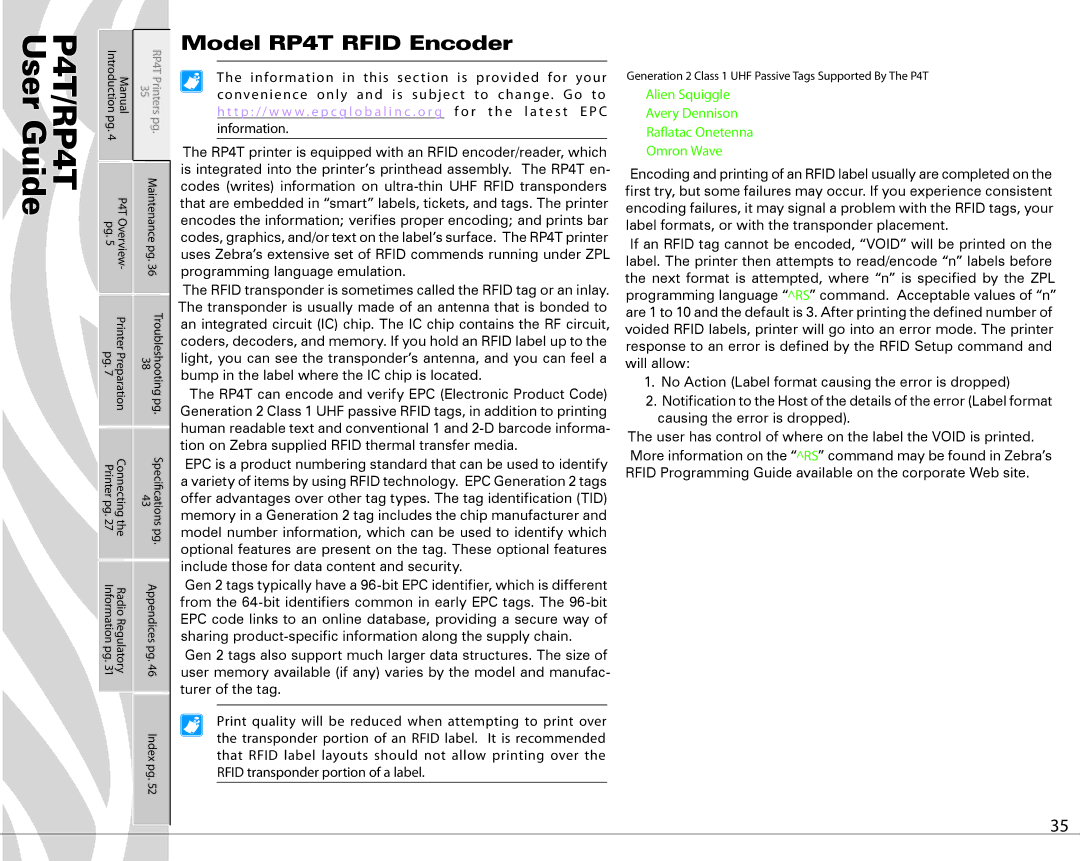
P4T/RP4T User Guide
Manual Introduction | RP4T Printers 35 | |
pg. | pg. | |
4 |
|
|
P4T Overview- pg. 5 | Maintenance pg. 36 | |
Printer Preparation pg. 7 | 38 | Troubleshooting pg. |
Connecting the Printer pg. 27 | 43 | Speci†cations pg. |
Radio Regulatory Information pg. 31 | Appendices pg. 46 | |
| Index pg. 52 | |
Model RP4T RFID Encoder
The information in this section is provided for your convenience only and is subjec t to change . Go to h t t p : / / w w w . e p c g l o b a l i n c . o r g f o r t h e l a t e s t E P C information.
The RP4T printer is equipped with an RFID encoder/reader, which is integrated into the printer’s printhead assembly. The RP4T en- codes (writes) information on
The RFID transponder is sometimes called the RFID tag or an inlay. The transponder is usually made of an antenna that is bonded to an integrated circuit (IC) chip. The IC chip contains the RF circuit, coders, decoders, and memory. If you hold an RFID label up to the light, you can see the transponder’s antenna, and you can feel a bump in the label where the IC chip is located.
The RP4T can encode and verify EPC (Electronic Product Code) Generation 2 Class 1 UHF passive RFID tags, in addition to printing human readable text and conventional 1 and
EPC is a product numbering standard that can be used to identify a variety of items by using RFID technology. EPC Generation 2 tags offer advantages over other tag types. The tag identification (TID) memory in a Generation 2 tag includes the chip manufacturer and model number information, which can be used to identify which optional features are present on the tag. These optional features include those for data content and security.
Gen 2 tags typically have a
Gen 2 tags also support much larger data structures. The size of user memory available (if any) varies by the model and manufac- turer of the tag.
Print quality will be reduced when attempting to print over the transponder portion of an RFID label. It is recommended that RFID label layouts should not allow printing over the RFID transponder portion of a label.
Generation 2 Class 1 UHF Passive Tags Supported By The P4T
Alien Squiggle
Avery Dennison
Ra«atac Onetenna
Omron Wave
Encoding and printing of an RFID label usually are completed on the first try, but some failures may occur. If you experience consistent encoding failures, it may signal a problem with the RFID tags, your label formats, or with the transponder placement.
If an RFID tag cannot be encoded, “VOID” will be printed on the label. The printer then attempts to read/encode “n” labels before the next format is attempted, where “n” is specified by the ZPL programming language “^RS” command. Acceptable values of “n” are 1 to 10 and the default is 3. After printing the defined number of voided RFID labels, printer will go into an error mode. The printer response to an error is defined by the RFID Setup command and will allow:
1.No Action (Label format causing the error is dropped)
2.Notification to the Host of the details of the error (Label format causing the error is dropped).
The user has control of where on the label the VOID is printed.
More information on the “^RS” command may be found in Zebra’s RFID Programming Guide available on the corporate Web site.
35
